Decor
How to Create an Eye-Catching Brick Wall Accent
Wondering how to transform your space? Discover the secrets to creating a captivating brick wall accent that will leave you in awe.
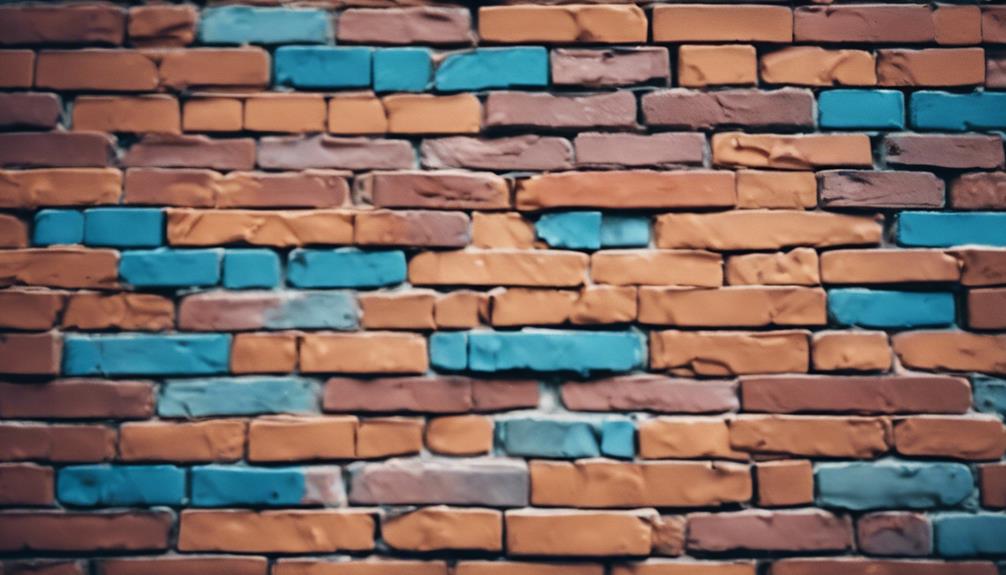
To create an eye-catching brick wall accent, start by prioritizing areas with ample natural light and choosing a wall with minimal obstructions and a smooth surface. Meticulously clean the brick, repair any cracks, and sand rough areas before applying a suitable primer for masonry surfaces. Consider bold paint colors like navy blue or explore whitewashing for a rustic look. Enhance with lighting like uplighting and LED strip lights, and incorporate decorative elements such as open shelving and artwork. Admire the transformed space with red brick's pop of color, rough texture's history, and a cozy ambiance. A stunning design transformation awaits.
Key Takeaways
- Choose a focal point wall with ample natural light.
- Repair and prepare the brick surface meticulously.
- Opt for a bold paint color or consider leaving the brick natural.
- Enhance with strategic lighting for depth and texture.
- Decorate with elements that complement the brick's charm.
Choosing the Right Wall
When selecting the ideal wall for a brick accent, prioritize areas that receive ample natural light to enhance the texture and color variations of the bricks.
Accent walls with exposed brick can truly transform a space, adding character and warmth.
To create a focal point, opt for a wall that serves as a main feature in the room, drawing the eye and creating visual interest.
It's important to choose a wall with minimal obstructions such as windows or doors, as this allows for a seamless and uninterrupted display of the brick.
Additionally, selecting a wall with a smooth surface is vital to guarantee proper adhesion of the brick material, preventing any issues with installation or longevity.
Look for a wall with enough space to showcase the full beauty and impact of the brick accent, allowing it to stand out and make a statement in the room.
Surface Preparation and Repair
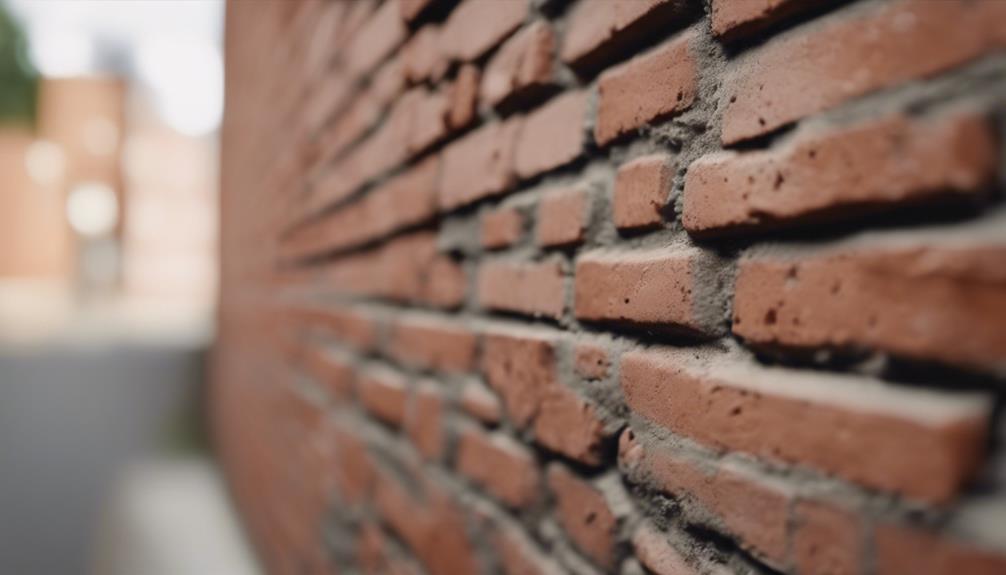
Before starting the accent wall project, it's essential to clean the brick surface meticulously, ridding it of any dirt, dust, or debris.
Next, repairing any cracks or holes with a suitable mortar or patching compound is vital to guarantee a flawless finish.
Sanding down rough areas on the brick will create a smooth base for the accent wall to be installed seamlessly.
Clean Brick Surface
To prepare the brick surface for accentuating, we must thoroughly clean and repair any imperfections to guarantee a flawless finish. Cleaning the brick wall is important to guarantee proper adhesion of coatings.
Begin by removing dust, dirt, and debris using a stiff brush or vacuum. For stubborn stains, mold, or mildew, consider pressure washing the wall before any treatments. Spot-treat remaining stains or discoloration with a mild detergent or brick cleaner for a pristine look.
Repair any damaged or crumbling bricks using brick repair mortar to create a smooth surface suitable for painting or sealing. It's essential to allow the brick wall to dry completely before proceeding with any decorative treatments. Moisture-related issues can be avoided by making sure the wall is thoroughly dry.
Repair Any Damage
Inspect the exposed brick wall thoroughly for any cracks, holes, or damage that requires repair before proceeding with the accent wall preparation.
Utilize a suitable mortar mix to fill in any gaps or cracks in the brick wall, ensuring a smooth and even surface for the accent application.
Sand down any rough or uneven areas on the brick wall to create a clean and uniform base for the accent design.
Cleaning the brick wall meticulously is essential to remove any dirt, dust, or debris that could compromise the adhesion of paint or other materials used for the accent.
Proper priming of the brick wall before applying any paint or finish is vital. This step will enhance adhesion and contribute to a more polished, professional-looking result for the accent wall.
Applying Primer for Brick

Applying primer for brick is essential in ensuring a successful paint job.
We need to focus on preparing the brick surface adequately, choosing a suitable primer, and applying it evenly.
These steps will help us achieve a professional finish and enhance the longevity of the paint on the brick surface.
Preparing Brick Surface
Why is it essential to apply a high-quality primer specifically designed for masonry surfaces before painting a brick wall?
When creating a brick accent wall, the use of primer plays an important role in ensuring the success of your project.
The primer acts as a bonding agent, enhancing adhesion between the porous brick surface and the paint to be applied. By sealing the brick's pores, the primer facilitates a more uniform and effective paint application, resulting in a smoother finish.
Additionally, the primer helps to prevent issues such as peeling or chipping of the paint over time, leading to a longer-lasting and professional-looking outcome.
It's imperative to select a primer that's compatible with both the brick surface and the type of paint intended for use, as this will contribute significantly to the durability and aesthetics of the final result.
Properly preparing the brick surface with a suitable primer lays the foundation for a successful and visually appealing brick accent wall.
Choosing Suitable Primer
How can we guarantee proper adhesion and a smooth finish when selecting a suitable primer for painting a brick wall? When it comes to priming an exposed brick wall for a fresh coat of white paint, choosing the right primer is essential. A high-quality bonding primer designed for masonry surfaces is vital to make sure the paint adheres properly to the rough texture of the brick. If the brick wall has any stains or discoloration that need to be concealed, opting for a stain-blocking primer is advisable. Additionally, using a tinted primer in a shade similar to the desired paint color can help reduce the number of paint coats required for full coverage.
Here is a table summarizing key points for selecting a suitable primer for painting a brick wall:
| Primer Type | Purpose | Recommendation |
|---|---|---|
| Bonding Primer | Ensures proper adhesion to brick | Use high-quality masonry bonding primer |
| Stain-blocking Primer | Conceals stains and discoloration | Opt for a primer with stain-blocking properties |
| Tinted Primer | Reduces number of paint coats needed | Consider using a tinted primer close to desired paint color |
Applying Primer Evenly
For a smooth and consistent base for painting the brick wall, we highly recommend using a high-quality primer specifically designed for masonry surfaces. When applying primer to brick, it's essential to guarantee proper adhesion and create an ideal surface for the paint or whitewash to adhere to.
Here are some key steps to follow when applying primer evenly:
- Choose the Right Primer: Select a primer that's formulated for masonry surfaces to promote adhesion and long-lasting results.
- Even Application: Use a paint roller or brush to apply the primer evenly across the brick surface, including mortar joints, to achieve a seamless base for painting.
- Complete Coverage: Make sure to cover the entire brick wall with primer to ensure consistent coverage and a uniform finish.
- Allow for Drying: Let the primer dry completely according to the manufacturer's instructions before proceeding with the next steps to guarantee optimal adhesion and a professional outcome.
Properly priming the brick wall is essential for a successful painting or whitewashing project, enhancing the overall aesthetic appeal and durability of the finish.
Selecting Paint Color or Leaving Natural
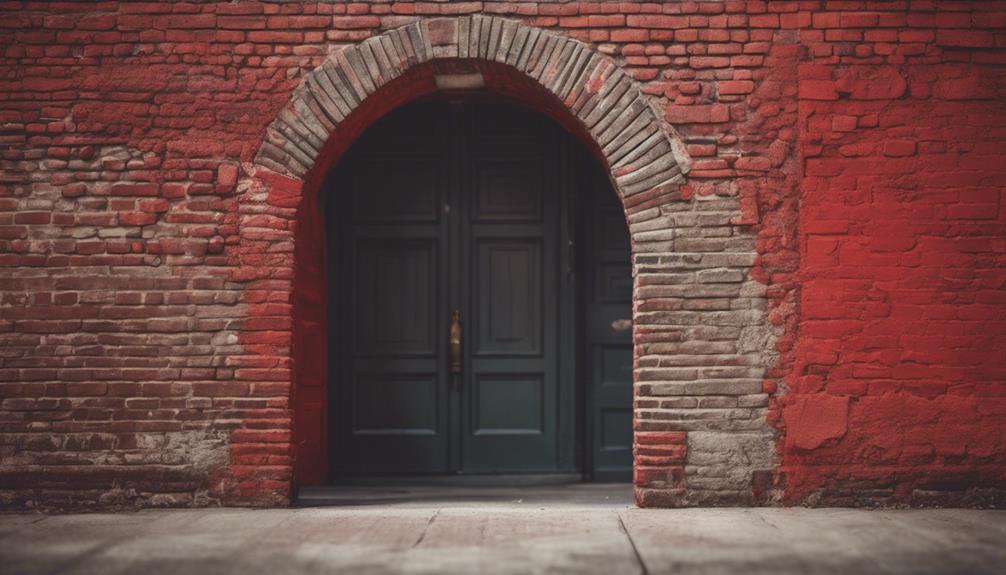
Considering the various options for the brick wall, whether to select a paint color or leave it natural is a key decision in creating an eye-catching accent.
Painting the brick wall in bold colors like navy blue or emerald green can make a striking statement, adding a vibrant touch to the space.
On the other hand, whitewashing the brick wall offers a softer, more rustic look, maintaining the brick's texture while brightening the room.
Leaving the brick wall natural enhances its organic charm, providing a warm and earthy feel to the area.
Opting for a light gray paint color gives a modern and elegant vibe, blending well with various decor styles.
Dark charcoal or black paint, on the other hand, introduces drama and sophistication, creating a striking contrast within the room.
Whether choosing a faux brick finish, a herringbone pattern, or a traditional brick layout, the paint color decision can have a significant impact on the overall aesthetic of the accent wall.
Enhancing With Lighting

Let's enhance the brick wall's appeal by strategically incorporating lighting techniques.
- Utilize uplighting: Highlight the texture and depth of the brick wall by positioning lights at the base to illuminate upwards, casting shadows that accentuate the rugged surface. This technique adds a sense of drama and architectural interest.
- Integrate wall sconces or pendant lights: These fixtures can provide a striking contrast against the brick surface, creating a visual focal point. By carefully selecting the design and placement, you can enhance the overall aesthetics of the wall.
- Install LED strip lights: For a modern touch, consider installing LED strip lights behind the brick. This subtle lighting option can bring a contemporary flair to the space while softly illuminating the wall's surface.
- Create a cozy ambiance with warm-toned fixtures: Choose light fixtures with warm tones that complement the brick's color, enhancing the overall atmosphere of the room. Adjust the lighting angles to experiment with shadows and highlights, adding depth and dimension to the brick wall.
Incorporating Decorative Elements
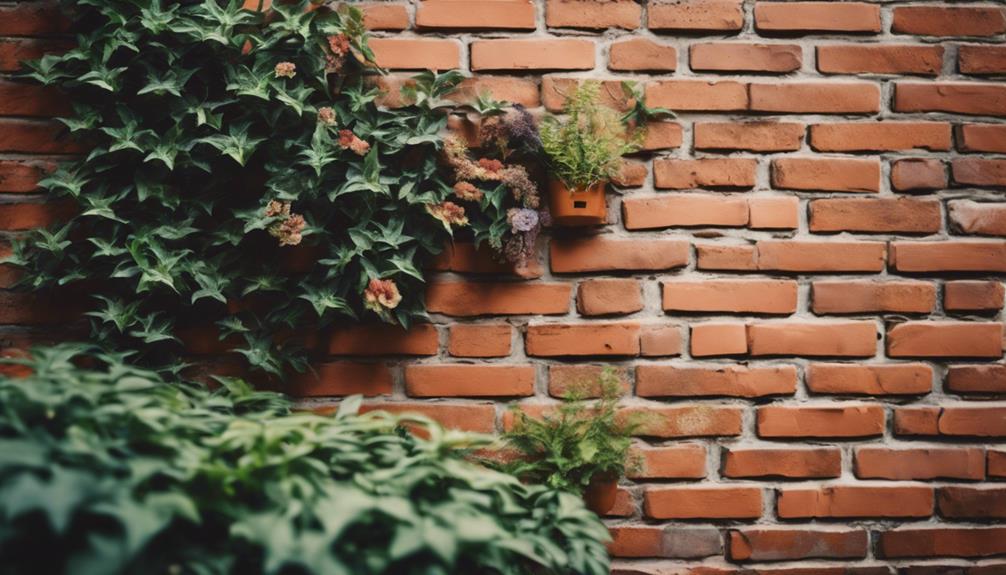
As we explore incorporating decorative elements, we can enhance the charm and character of the brick wall accent by strategically placing artwork and decorative objects. These elements provide a striking contrast to the ruggedness of the brick, adding depth and visual interest to the space.
Open shelving can be used to display treasured items, creating a personalized touch that complements the brick backsplash. To achieve a balanced and visually appealing design, consider pairing the brick wall with a variety of different rustic and refined elements.
Playful touches and unique decor pieces can inject a youthful and vibrant vibe into the interior design, elevating the overall aesthetic of the space. Opting for a color palette of white and wood can further enhance the natural appeal of the brick wall accent, creating a harmonious and inviting atmosphere.
Admiring the Transformed Space
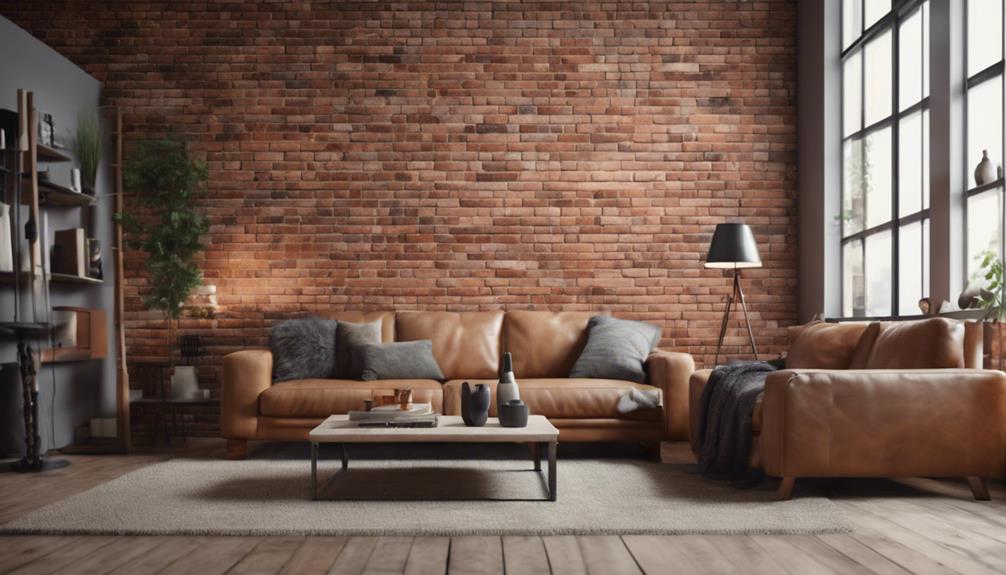
We can't help but be entranced by the remarkable transformation that occurs when a brick wall accent is integrated into a space. The walls come alive with a dynamic energy, especially when the timeless allure of red brick meets the modern design trends of today.
Here are some key aspects to admire about the transformed space:
- Enhanced Walls: The red brick adds a pop of color that contrasts beautifully with surrounding elements, creating a striking focal point in the room.
- Rich Texture: The rough texture of the exposed brick brings a sense of history and depth, adding a layer of character that elevates the overall ambiance.
- Warmth and Coziness: The earthy tones of the brick radiate warmth, making the space feel inviting and cozy, perfect for relaxing or entertaining.
- Visual Interest: The play of light and shadow on the textured surface of the brick wall accentuates its unique features, creating a visually captivating experience for anyone who enters the room.
Frequently Asked Questions
How Can I Make My Brick Wall More Attractive?
To make a brick wall more attractive, we can incorporate lighting fixtures to accentuate texture and color variations.
Contrasting paint colors create a bold look, while floating shelves or artwork add interest and break visual monotony.
Mixing brick sizes or patterns offers a unique design.
Adding plants softens the industrial feel.
These methods combine to enhance the brick wall's aesthetic appeal and create an eye-catching focal point in any space.
How to Decorate a Brick Accent Wall?
When decorating a brick accent wall, consider incorporating artwork and open shelving for a contrasting effect.
Pair rustic and refined elements to achieve a balanced look.
Add playful touches to maintain a youthful and creative vibe.
Opt for a white and wood palette to enhance the wall's natural appeal.
Utilize vibrant paint colors to make a bold statement.
These strategies can help create an eye-catching brick accent wall that's visually appealing and unique. By exploring various DIY brick accent wall ideas, you can personalize the look to fit your interior design style, whether it’s rustic, industrial, or modern. Try experimenting with different brick colors, textures, or even painting techniques to make the wall truly stand out. Incorporating lighting fixtures or decor elements can further highlight the charm and depth of the brickwork.
How to Get Brick Effect on Wall?
To achieve a brick effect on a wall, one can opt for real bricks, faux brick panels, or brick wallpaper.
Real bricks provide an authentic appearance but require individual installation.
Faux options, such as lightweight and cost-effective faux brick panels, offer easier DIY projects.
Brick wallpaper is a convenient alternative that mimics the look of bricks without the need for actual masonry.
Consider factors like maintenance, cost, and installation complexity when choosing the method for your brick wall.
How to Make Exposed Brick Look Good?
When making exposed brick look good, consider the surrounding decor elements. Artwork and open shelving can counterbalance the rawness of brick, creating a harmonious blend.
Opting for a white and wood color scheme enhances the brick's natural charm. Adding playful touches injects a youthful energy into the space. Pairing rustic and refined pieces with the brick can elevate the overall design.
Whitewashing the brick can create a chic, aged aesthetic with red accents.
Conclusion
In choosing the right wall, preparing the surface, applying primer, selecting paint, enhancing with lighting, and incorporating decorative elements, we've transformed a simple brick wall into an eye-catching accent.
By following these steps, the space has been elevated to a new level of style and sophistication.
Embrace the beauty of your newly transformed brick wall and enjoy the impact it brings to your living space.
- About the Author
- Latest Posts
Introducing Ron, the home decor aficionado at ByRetreat, whose passion for creating beautiful and inviting spaces is at the heart of his work. With his deep knowledge of home decor and his innate sense of style, Ron brings a wealth of expertise and a keen eye for detail to the ByRetreat team.
Ron’s love for home decor goes beyond aesthetics; he understands that our surroundings play a significant role in our overall well-being and productivity. With this in mind, Ron is dedicated to transforming remote workspaces into havens of comfort, functionality, and beauty.

Have you ever considered that a thoughtfully designed and customized space can greatly influence a boy’s growth and joy? By incorporating some creativity and a bit of expertise, you can craft the ideal sanctuary for your child.
In this article, I’ll guide you through the process of building boys room decor, from choosing the theme and color scheme to selecting furniture and adding personalized touches.
Get ready to transform your son’s space into a place where he can dream, play, and grow.
Key Takeaways
- Consider the boy’s interests and preferences for the theme
- Utilize multi-purpose furniture and storage solutions
- Personalize walls with DIY wall decor using child’s artwork or repurposed items
- Incorporate personalized touches to make the room truly their own
Choosing the Theme
When choosing the theme for your boy’s room decor, it’s important to consider his interests and preferences.
Bedding options and lighting fixtures play a crucial role in creating a cohesive and inviting space. For bedding, you can opt for fun patterns like superheroes, sports, or animals, which can bring his favorite characters or hobbies to life. Complement the bedding with coordinating curtains and throw pillows to add depth and texture.
Lighting fixtures can contribute to the overall ambiance of the room. Consider installing a ceiling fan with built-in lights or a desk lamp for reading and studying. By selecting bedding options and lighting fixtures that align with your boy’s interests, you can create a personalized and comfortable space.
Now, let’s move on to selecting the right color scheme, which will further enhance the room’s aesthetic appeal.
Selecting the Right Color Scheme
Choosing the perfect color scheme for your little guy’s space is essential in creating a cohesive and inviting atmosphere. When it comes to selecting the right colors for a boy’s room, considering color psychology can be helpful.
Blue, for example, is known for its calming and soothing effects, perfect for creating a serene environment. Green is another great choice, as it promotes a sense of harmony and balance.
To add a pop of personality to the room, consider accent wall options. Whether it’s a bold stripe, a geometric pattern, or a superhero-themed mural, an accent wall can instantly transform the space and add visual interest.
Now that we’ve covered the importance of color, let’s move on to exploring furniture and storage solutions that will help maximize your little one’s space.
Furniture and Storage Solutions
Now that we’ve covered the importance of color, let’s take a look at some furniture and storage solutions that will help maximize your little one’s space.
When it comes to furniture arrangement, here are three organization hacks that will make a big difference in your boy’s room:
-
Utilize multi-purpose furniture: Opt for a loft bed with built-in storage or a desk with drawers. These pieces will provide functionality without taking up extra space.
-
Use vertical storage: Install floating shelves or wall-mounted bookcases to free up floor space. You can also hang hooks or pegboards to keep hats, bags, and other accessories neatly organized.
-
Invest in storage bins and baskets: These versatile containers are perfect for storing toys, clothes, and other belongings. Label them for easy identification and teach your child the importance of tidiness.
By implementing these furniture and storage solutions, you’ll create a more organized and spacious room for your little one.
Now, let’s move on to some DIY wall decor ideas that will add a personal touch to the space.
DIY Wall Decor Ideas
There are many creative and budget-friendly ways to personalize the walls in your child’s space. One of my favorite ways to add a personal touch is through DIY wall art. You can create unique and meaningful pieces by using your child’s artwork, photographs, or even repurposing old items. Get creative with materials like canvas, wood, or even fabric to make stunning wall decor that reflects your child’s interests and personality.
Another fun option is to use creative wall decals. These removable stickers come in various designs and can be easily applied and removed without damaging the walls. They are perfect for adding a pop of color or a whimsical touch to your child’s room. You can find an array of options online or even make your own using printable designs or stencils.
Adding Personalized Touches
You can easily personalize your child’s space by incorporating their artwork or photographs into DIY wall decor. It’s a simple and meaningful way to showcase their creativity and make their room truly their own.
Here are three ideas to inspire you:
-
Create a gallery wall: Gather your child’s artwork and frame it in coordinating frames. Arrange the frames on the wall to create a gallery-style display. This will not only add a personal touch to the room but also serve as a conversation starter when guests come over.
-
Custom wall decals: Design and create custom wall decals using your child’s favorite quotes, sayings, or drawings. You can find online services that allow you to upload your designs and have them turned into decals. Apply them to the walls to add a unique touch to the room.
-
Personalized bedding: Choose bedding that reflects your child’s interests and personality. Look for options that can be personalized with their name or initials. This will not only make their bed feel special but also add a personalized touch to the entire room.
Frequently Asked Questions
How Can I Incorporate Educational Elements Into My Boy’s Room Decor?
Incorporating learning tools into my boy’s room decor is a great way to make it educational. By adding interactive wall art, a reading nook, and organizing bedtime routine essentials, his room becomes a fun and educational space.
What Are Some Budget-Friendly Options for Furniture and Storage Solutions?
When it comes to designing a boy’s room, finding budget-friendly furniture options and creative storage solutions is key. Let me share some ideas that will help you create a stylish and functional space without breaking the bank.
Are There Any Tips for Creating a Cohesive Color Scheme While Still Allowing for Personalization?
Creating a personalized color palette while finding balance between style and personalization is key. Start by selecting a base color and then adding accent colors that reflect your child’s interests. Don’t be afraid to mix and match patterns and textures for added visual interest.
Can You Recommend Any Unique DIY Wall Decor Ideas That Are Easy to Execute?
Sure, I can recommend some unique DIY wall decor ideas that are easy to execute. From creating a gallery wall with vintage record covers to crafting geometric wall art with washi tape, the options are endless!
How Can I Create a Space That Will Grow With My Son’s Changing Interests and Preferences Over Time?
To create a space that grows with my son’s changing interests, I focus on creating personalized artwork and incorporating interactive elements. This allows for flexibility and ensures that the room can easily adapt to his evolving preferences over time.
Can Wood Quilt Decor Ideas Be Incorporated into Boys Room Decor?
Yes, wood quilt decor tutorial can be incorporated into boys room decor to add a rustic and cozy touch. Using wooden quilted wall art, shelves, or even a wooden quilt-inspired headboard can bring warmth and texture to the room. The natural elements of wood complement the rugged and adventurous theme of a boys room.
Conclusion
In conclusion, building a boy’s room decor is a creative and detail-oriented process. It requires careful consideration of the theme, color scheme, furniture, and personalized touches.
With the right combination of elements, you can create a space that reflects your child’s personality and interests. Whether it’s a sports-themed room or a space-inspired design, allowing your imagination to run wild will result in a room that not only looks great but also provides a cozy and comfortable environment for your little one.
So, embrace your inner designer and let the rhythm of your creativity guide you in creating a room that will make your child’s dreams come true.
- About the Author
- Latest Posts
Meet Bethia, the visionary designer at ByRetreat who brings a touch of magic to every remote workspace she creates. With a boundless imagination and an eye for beauty, Bethia is passionate about transforming ordinary spaces into extraordinary havens of creativity and comfort.
Bethia possesses a unique talent for envisioning the perfect combination of furniture, colors, and textures that harmonize seamlessly in a room. She understands that selecting furniture goes beyond mere functionality; it’s about curating pieces that evoke a sense of style and sophistication while enhancing the overall ambiance.
Architecture Home Styles
What Are the Differences Between Tiny Vs Micro Homes?
Keen to unravel the subtle yet significant contrasts between tiny and micro homes? Discover the fascinating distinctions that go beyond their sizes in this insightful comparison.
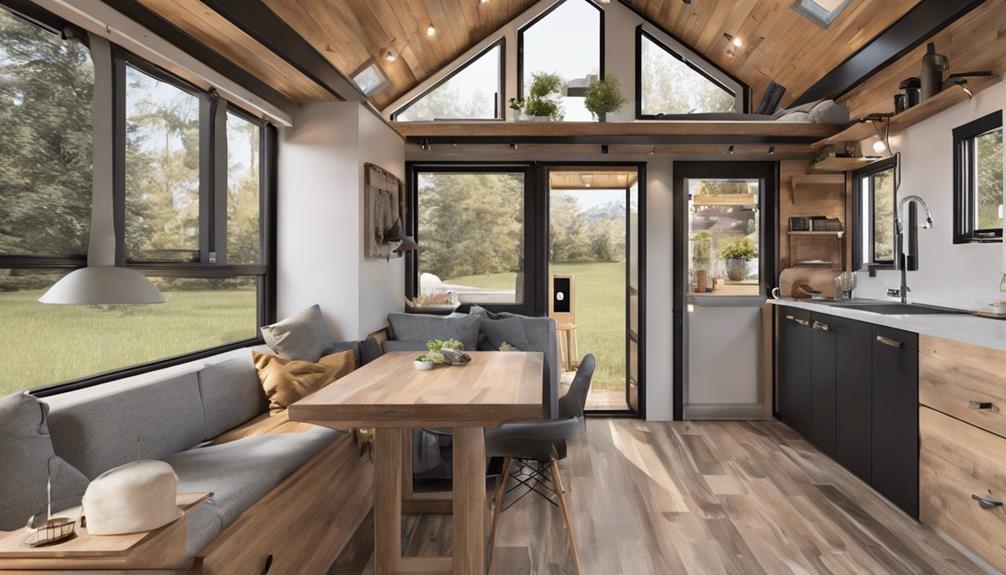
When comparing tiny homes to micro homes, it’s like different shades of a color spectrum; at first glance, they might seem similar, but upon closer inspection, their distinctions become apparent.
The nuances between these compact living spaces go beyond mere square footage. Let's explore how size, mobility, cost, design, and environmental factors play into the choice between tiny and micro homes.
Key Takeaways
- Tiny homes are smaller (under 400 sq ft) and focus on minimalism.
- Micro homes offer more space (400-800 sq ft) and additional amenities.
- Micro homes cost more ($40,000-$80,000) due to size and amenities.
- Tiny homes prioritize mobility, while micro homes balance functionality and style.
Size and Square Footage Variances
When comparing tiny homes to micro homes, the key distinction lies in their size and square footage variances. Tiny homes typically measure under 400 square feet, emphasizing minimalism and compact living.
In contrast, micro homes range from 400 to 800 square feet, offering more space for amenities such as bathrooms, kitchens, and porches. The extra square footage in micro homes allows for a more comfortable living experience compared to tiny homes.
This difference in size impacts the overall livability and functionality of the house, with micro homes providing a slightly larger footprint for occupants. While both tiny and micro homes are part of the tiny house movement, micro homes are often seen as an upgrade due to their ability to offer a bit more breathing room within the small house concept.
The choice between tiny and micro homes ultimately depends on individual preferences for space and comfort within the constraints of small living arrangements.
Mobility and Portability Distinctions

Moving from the discussion on size and square footage variances between tiny and micro homes, an important aspect to consider is the distinctions in mobility and portability features of these compact living spaces. Tiny homes are often constructed with wheels, allowing for easy relocation and travel, catering to individuals seeking a portable lifestyle. On the other hand, micro homes, although slightly larger in size, are also designed with portability in mind, offering the flexibility to move if needed. Both tiny and micro homes provide the freedom to change living environments and embrace a mobile lifestyle.
| Features | Tiny Homes | Micro Homes |
|---|---|---|
| Mobility | Built on wheels for travel | Designed for easy relocation |
| Portability | Emphasis on easy relocation | Offers flexibility to move |
| Flexibility | Allows for changes in location | Can be moved if necessary |
| Lifestyle | Enables a portable lifestyle | Provides a sense of freedom |
| Travel | Ideal for those who value travel | Suited for a mobile lifestyle |
Cost Disparities Between Tiny and Micro Homes
The cost differentials between tiny and micro homes are primarily influenced by factors such as size, materials, and included amenities. Tiny homes typically range from $15,000 to $60,000 to build, making them more budget-friendly compared to micro homes, which can cost between $40,000 to $80,000. This cost disparity is mainly due to the size difference between the two housing options. Micro homes, being larger than tiny homes, require a higher investment but offer more space and features.
In terms of materials, both tiny and micro homes can vary greatly depending on the builder and design choices. However, the larger size of micro homes may necessitate more materials, contributing to the higher overall cost. Additionally, micro homes often come with added amenities such as full kitchens, bathrooms, and living spaces, which can also increase the final price tag. On the other hand, tiny homes are designed to be more compact and minimalist, focusing on essential living spaces to keep costs lower while still providing a comfortable living environment.
Design and Style Contrasts

Considering the distinctive cost disparities between tiny and micro homes, it's essential to explore the contrasting design and style elements that define these two compact living options. Tiny homes often embrace a cozier and more traditional aesthetic, with design choices like pitched roofs, rustic wood finishes, and lofted sleeping areas that maximize vertical space. In contrast, micro homes lean toward sleek, minimalist styles, incorporating cutting-edge technology and innovative layouts with an emphasis on multifunctional furniture. By examining the balance of traditional vs modern house features, one can better understand how these compact living spaces cater to varying tastes, needs, and budgets.
Tiny homes typically embrace a minimalist and modern design approach, focusing on simplicity and functionality. In contrast, micro homes often offer a more spacious layout, providing additional amenities like a porch and a separate bathroom, catering to those seeking a balance between compact living and comfort.
While tiny homes prioritize mobility and efficiency in their design, micro homes strike a balance between functionality and style. Micro homes may also lean towards a more traditional house appearance, contrasting the unique and often unconventional designs found in tiny homes.
Whether one prefers the sleek, contemporary look of tiny homes or the more traditional and spacious feel of micro homes, both options offer innovative solutions for those seeking compact living without sacrificing style or functionality.
Environmental Impact Variances
When examining the environmental impact variances between tiny and micro homes, it becomes evident that their size and resource utilization play a crucial role in determining their eco-friendliness.
Tiny homes have a smaller environmental footprint due to their reduced size and resource consumption. These compact dwellings often use eco-friendly construction materials and incorporate energy-efficient features to enhance sustainability.
In contrast, micro homes, though slightly larger, still prioritize environmental consciousness by utilizing green technologies such as solar panels and rainwater harvesting systems.
Both tiny and micro homes offer options for off-grid living, with tiny homes being more easily adaptable for sustainable practices like solar power and composting toilets. Micro homes strike a balance between eco-friendliness and comfortable living space, attracting those who seek a middle ground between tiny and traditional homes.
Frequently Asked Questions
What Is the Difference Between a Tiny Home and a Micro Home?
When looking at a tiny home versus a micro home, the distinction lies in size and functionality. Tiny homes are typically under 400 square feet, while micro homes range from 400-800 square feet, offering more space and amenities.
While tiny homes are known for affordability and minimalism, micro homes provide a bit more room for comfortable living, often functioning as independent living spaces with their own bathroom and kitchen.
What Classifies as a Tiny Home?
We consider a tiny home as a dwelling that's typically under 400 square feet in size, crafted with the essence of simplicity and functionality. These homes are designed to cater to the needs of a minimalist lifestyle, emphasizing efficiency and sustainability.
In essence, a tiny home symbolizes the liberation from excess, offering a cozy sanctuary that prioritizes mindful living and resourcefulness.
How Big Are Micro Homes?
Micro homes typically range from 400 to 800 square feet, offering more living space than tiny houses. They're designed for independent living and include essential amenities like a bathroom, kitchen, and porch.
Despite their compact size, micro homes are fully functional houses suitable for individuals or couples seeking efficient living spaces. Their layout optimizes every inch, creating a cozy yet practical environment for modern living.
Is 600 Sq Ft Considered a Tiny House?
We believe that 600 square feet is typically considered a small home rather than a tiny house. While tiny houses are usually under 400 square feet, small homes can range up to 1000 square feet.
This size difference impacts the space utilization and features available in the house. Small homes provide more room for comfort and amenities compared to tiny houses, with 600 square feet offering enough space for essential living areas in a small home setting.
Conclusion
In conclusion, the differences between tiny and micro homes are as vast as the ocean and as intricate as a spider's web. From size variations to cost disparities, each type offers a unique living experience tailored to different preferences and needs.
While tiny homes focus on minimalism and affordability, micro homes provide more space and functionality. Both options have their own advantages and drawbacks, but ultimately offer a sustainable and environmentally friendly housing solution for those seeking a simpler lifestyle.
- About the Author
- Latest Posts
Introducing Ron, the home decor aficionado at ByRetreat, whose passion for creating beautiful and inviting spaces is at the heart of his work. With his deep knowledge of home decor and his innate sense of style, Ron brings a wealth of expertise and a keen eye for detail to the ByRetreat team.
Ron’s love for home decor goes beyond aesthetics; he understands that our surroundings play a significant role in our overall well-being and productivity. With this in mind, Ron is dedicated to transforming remote workspaces into havens of comfort, functionality, and beauty.

Want to add some spooky vibes to your home this Halloween? Not sure where to find the top Halloween decorations? Look no more! This article will unveil the answer to the question on everyone’s mind: which stores sell Halloween decor?
Whether you prefer to shop online or explore local retailers, I’ve got you covered. From party supply stores to specialty Halloween shops, I’ll provide you with a comprehensive list of the best places to find ghoulish goodies.
So, let’s get started on transforming your home into a haunted haven!
Key Takeaways
- Online retailers offer a wide selection of Halloween decor and provide the convenience of online shopping and price comparison.
- Party supply stores are the go-to destination for creating a spooky atmosphere at home, with a variety of party themes and DIY decoration options.
- Home decor stores, including budget-friendly options like Dollar Tree and Walmart, offer a wide variety of Halloween decor with factors to consider such as quality, variety, and price.
- Big-box retailers like Target and Walmart offer a larger selection and more affordable prices, while specialty stores provide a more unique and specialized selection of Halloween decor.
Online Retailers
You can find a wide selection of Halloween decor from online retailers. These retailers offer unique Halloween decorations that can add a spooky touch to your home.
Whether you’re looking for creepy props, eerie lighting, or hauntingly beautiful decorations, online retailers have it all.
One advantage of shopping online for Halloween decor is the convenience. You can browse through different websites and compare prices without leaving your home.
Another benefit is the availability of DIY Halloween decoration ideas. Many online retailers offer tutorials and inspiration for creating your own decorations, allowing you to personalize your Halloween decor and make it truly unique.
Now, let’s move on to the next section, where we will explore party supply stores and their offerings.
Party Supply Stores
Party supply stores typically have a wide selection of Halloween decorations available. They are a go-to destination for anyone planning a Halloween party or looking to create a spooky atmosphere at home. These stores offer a variety of party themes, allowing customers to choose decorations that match their desired aesthetic.
Additionally, party supply stores often provide DIY decorations, giving customers the opportunity to personalize their Halloween decor. From table centerpieces to hanging bats and skeletons, these stores have everything you need to transform your space into a haunted haven.
However, if you’re looking for a wider range of options and higher-quality items, home decor stores may be a better choice.
Home Decor Stores
When it comes to finding popular Halloween decor stores, there are several options to consider.
From well-known retailers like Party City and Spirit Halloween, to specialty stores like Halloween Express, there are plenty of places to find spooky decorations.
Additionally, online options are available, allowing for convenient shopping and a wider selection.
Lastly, for those on a budget, there are also budget-friendly stores like Dollar Tree and Walmart that offer affordable Halloween decor options.
Popular Halloween Decor Stores
Some of the most popular stores that sell Halloween decor include Spirit Halloween, Walmart, and Target.
When it comes to finding the best online options for unique Halloween decorations, there are a few key factors to consider.
- Quality: Look for stores that offer high-quality products that will last for years to come.
- Variety: Choose a retailer that offers a wide selection of different decorations, from spooky skeletons to cute pumpkins.
- Price: Compare prices across different stores to ensure you’re getting the best deal for your budget.
Now that we’ve explored the popular brick-and-mortar options, let’s dive into the world of online shopping and discover the wide range of options available to us.
Online Options Available
If you’re looking for a convenient way to shop for Halloween decorations, you can explore the wide range of online options available.
Online shopping provides a great opportunity to find unique and creative Halloween decorations without even leaving your home.
One of the advantages of shopping online is the ability to find DIY Halloween decor ideas. Many online retailers offer a variety of do-it-yourself kits and supplies that allow you to create your own spooky decorations.
Another tip for finding unique Halloween decorations online is to browse through specialized websites and marketplaces that focus specifically on Halloween items. These platforms often have a wide selection of one-of-a-kind decorations that you won’t find in traditional stores.
With so many online options available, you’re sure to find the perfect decorations to make your Halloween truly memorable.
Now, let’s move on to budget-friendly stores that offer great Halloween decor options.
Budget-Friendly Stores
After exploring online options for Halloween decor, I realized that there are also plenty of budget-friendly stores that sell affordable options. These stores are perfect for those who prefer DIY decorations or want to save some money while still getting into the spooky spirit. Here are a few options to consider:
-
Dollar stores: They often have a wide range of inexpensive Halloween decorations, from pumpkins and skeletons to spiderwebs and witches hats.
-
Thrift stores: You never know what hidden gems you might find at thrift stores. Look for second-hand Halloween decorations that can be easily repurposed or transformed into something uniquely spooky.
-
Craft stores: Craft stores usually offer a variety of affordable materials that you can use to create your own Halloween decorations, such as foam, paint, and glitter.
Now that we’ve explored affordable options and DIY decorations, let’s move on to the next section about big-box retailers and their Halloween offerings.
Big-Box Retailers
Target and Walmart are popular options for finding Halloween decor at big-box retailers. These stores offer a wide variety of spooky items, from inflatable decorations to creepy lights and everything in between.
When it comes to big box stores versus specialty stores, there are a few key differences to consider. For one, big box stores tend to have a larger selection and more affordable prices. They also offer the convenience of online shopping, allowing you to browse and purchase items from the comfort of your own home.
However, if you prefer the in-store shopping experience and want a more unique or specialized selection, specialty Halloween stores may be the way to go. These stores often have a more extensive range of high-quality and exclusive items, perfect for those looking to create a truly one-of-a-kind Halloween display.
Specialty Halloween Stores
When it comes to finding the best Halloween store, the debate between online and in-store shopping can be a tough one.
Online shopping offers convenience and a wide selection, allowing you to browse through countless options from the comfort of your own home.
However, visiting a physical store can provide a more immersive experience, with the opportunity to see and try on costumes and decorations in person.
Ultimately, the choice between online and in-store shopping for your Halloween needs depends on your personal preferences and what you value most in your shopping experience.
Best Halloween Store
The best Halloween store near me is Spirit Halloween. They have a wide selection of costumes, accessories, and decorations that are perfect for the spooky season. Here are three reasons why Spirit Halloween is the top choice for Halloween enthusiasts:
-
Extensive Variety: Spirit Halloween offers the best Halloween costumes, ranging from classic characters to trendy pop culture references. They have options for all ages and sizes, ensuring that everyone can find their perfect costume.
-
Quality Decorations: Whether you’re looking for DIY Halloween decorations or ready-made items, Spirit Halloween has it all. From creepy animatronics to stylish home decor, their selection is unmatched.
-
Knowledgeable Staff: The staff at Spirit Halloween is friendly and knowledgeable. They can help you find the perfect costume or offer suggestions for creating your own DIY decorations.
Now that we’ve explored the best Halloween store, let’s discuss the pros and cons of shopping for Halloween items online versus in-store.
Online Vs In-Store?
If you’re unsure whether to shop online or in person for your Halloween needs, you’ll find that both options have their advantages and drawbacks.
When it comes to shopping online for Halloween decor, there are several advantages to consider. Firstly, online stores often have a wider selection of unique and hard-to-find decorations. Additionally, you can easily compare prices and read reviews from other customers.
On the other hand, shopping in-store can also be a great option. It allows you to see and feel the items in person, which can be helpful when choosing the right decorations. Plus, you can take advantage of any sales or discounts that may not be available online.
To find unique in-store Halloween decorations, consider visiting specialty Halloween stores, thrift shops, or even local craft fairs. These places often have one-of-a-kind items that you won’t find anywhere else.
Transitioning into the next section about craft stores, I’ll share some tips on how to find the best Halloween decor in these establishments.
Craft Stores
Craft stores usually have a wide selection of Halloween decor. They are not only a great place to find ready-made decorations, but also provide a treasure trove of crafting materials for DIY projects.
Here are some reasons why craft stores are a go-to for Halloween decor:
-
Variety: Craft stores offer a diverse range of Halloween-themed items, from spooky figurines to intricately designed wreaths.
-
Customization: With crafting materials readily available, you can personalize your decorations and create unique pieces that match your style.
-
Project Inspiration: Craft stores often have displays and samples showcasing DIY projects, providing inspiration and ideas for your own Halloween decor creations.
Now, let’s explore another option for finding Halloween decor – discount stores. These stores offer affordable options without compromising on quality.
Discount Stores
Now that we’ve explored craft stores for Halloween decorations, let’s take a look at another affordable option: discount stores. These stores offer a wide range of Halloween decor at budget-friendly prices. From spooky skeletons to inflatable ghosts, discount stores have a variety of options to choose from. They often stock seasonal items and have dedicated sections for Halloween decorations.
You can find everything you need to transform your home into a haunted house without breaking the bank. Some popular discount store options include Walmart, Dollar Tree, and Target. These stores not only offer affordable decorations but also provide a convenient shopping experience.
Now, let’s move on to another great place to find unique and affordable Halloween decor: local thrift shops.
Local Thrift Shops
Thrift shops offer a wide selection of unique and affordable items for Halloween. I love exploring these stores and discovering hidden gems that can add a special touch to my Halloween decorations.
Here are some reasons why thrift store finds are perfect for DIY decorations:
-
Variety: Thrift shops have a diverse range of items, from vintage knick-knacks to old costumes. This variety allows you to find the perfect pieces to create a unique and personalized Halloween display.
-
Cost-effective: Buying second-hand items from thrift shops is a budget-friendly option. You can find great deals and save money while still achieving a spooky and festive atmosphere.
-
Sustainability: By repurposing thrift store finds for your DIY decorations, you are contributing to a more sustainable approach to Halloween. Giving new life to pre-loved items reduces waste and helps protect the environment.
Where Can I Find Halloween Tinsel and Other Decorations?
Looking for Halloween tinsel and other decorations? Hobby Lobby has a wide range of spooky options to choose from. From glittery tinsel to creepy figurines, you’ll find everything you need to make your Halloween decorations spooktacular. Check out Hobby Lobby’s tinsel options to add a festive touch to your haunted house this year.
Frequently Asked Questions
Can I Find Unique and Vintage Halloween Decorations at Local Thrift Shops?
Yes, you can find unique and vintage Halloween decorations at local thrift shops. They often have a wide variety of items that are one-of-a-kind and add a nostalgic touch to your Halloween decor.
Are There Any Online Retailers That Specialize in Handmade or Artisanal Halloween Decor?
There are many benefits to supporting handmade Halloween decor artisans. You can find unique and one-of-a-kind pieces online. Look for online retailers that specialize in artisanal decor to find the best deals.
Do Big-Box Retailers Offer a Wide Variety of Outdoor Halloween Decorations?
Yes, discount stores often have affordable outdoor Halloween decorations. Home improvement stores also carry a variety of Halloween decorations. They offer a wide range of options for customers looking to decorate their outdoor spaces.
Are There Any Specialty Halloween Stores That Offer Custom-Made or Personalized Decorations?
Specialty Halloween stores offer a unique selection of personalized decorations. They cater to individuals looking for customized items to make their Halloween decor stand out. It’s a great way to add a personal touch to your spooky celebrations.
Can I Find Halloween-Themed Craft Supplies at Craft Stores to Make My Own Decorations?
Yes, you can find Halloween-themed craft supplies at craft stores. They offer a variety of materials like foam shapes, glitter, and paint. Many craft stores also provide DIY Halloween decoration tutorials and ideas.
Conclusion
In conclusion, there are various stores where you can find Halloween decor to transform your home into a spooky paradise. From online retailers like Amazon and Etsy to party supply stores like Party City, the options are endless.
Home decor stores like Pier 1 Imports and Pottery Barn also offer a wide selection of Halloween decorations. Big-box retailers such as Walmart and Target are another option for affordable and diverse Halloween decor.
If you’re looking for specialty Halloween stores, Spirit Halloween and Halloween Express are great choices. Craft stores like Michaels and Jo-Ann Fabrics also have a range of Halloween-themed items.
Additionally, discount stores like Dollar Tree and local thrift shops can be treasure troves for unique and budget-friendly Halloween decor. For instance, a friend of mine recently found a vintage Halloween mask at a local thrift shop, which added a nostalgic touch to her Halloween party.
With so many options available, you’re sure to find the perfect Halloween decor to create a hauntingly beautiful atmosphere.
- About the Author
- Latest Posts
Meet Bethia, the visionary designer at ByRetreat who brings a touch of magic to every remote workspace she creates. With a boundless imagination and an eye for beauty, Bethia is passionate about transforming ordinary spaces into extraordinary havens of creativity and comfort.
Bethia possesses a unique talent for envisioning the perfect combination of furniture, colors, and textures that harmonize seamlessly in a room. She understands that selecting furniture goes beyond mere functionality; it’s about curating pieces that evoke a sense of style and sophistication while enhancing the overall ambiance.
-

 Decor5 days ago
Decor5 days agoMaximalist Decor Explained: Embrace More Style
-

 Vetted4 weeks ago
Vetted4 weeks ago15 Best Drip Irrigation Systems to Keep Your Garden Thriving
-

 Vetted1 week ago
Vetted1 week ago15 Best Foot Massagers for Neuropathy to Soothe Your Feet and Relieve Discomfort
-

 Vetted2 weeks ago
Vetted2 weeks ago15 Best Sports Laundry Detergents for Keeping Your Activewear Fresh and Clean
-

 Vetted3 weeks ago
Vetted3 weeks ago15 Best Tall Toilets for Seniors That Combine Comfort and Safety
-

 Vetted3 weeks ago
Vetted3 weeks ago15 Best Dish Scrubbers to Keep Your Kitchen Sparkling Clean
-

 Decor3 weeks ago
Decor3 weeks agoWhat Is Eclectic Home Decor
-

 Vetted2 days ago
Vetted2 days ago15 Best Organic Pest Control Solutions for a Naturally Pest-Free Home


























